Beaches on the island of Rhodes
The total length of the coastline of the Greek island of Rhodes is almost 250 km and beaches can be found almost all around its perimeter. The type of the beaches on Rhodes is generally determined by whether they lie on the east or west coast of the island and whether they are adjacent to a busy tourist resort or a small, quiet village.
The beaches of Rhodes are very varied and Rhodes offers both sandy and pebbly beaches, beaches with facilities and suitable for relaxation, as well as windswept beaches popular among surfers. However, you can always count on the sea to be beautifully clean and pleasantly warm in the peak tourist season.
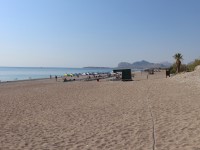
Afandou
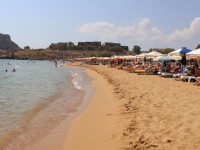
Agathi (Agia Agatha)
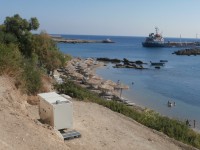
Agia Marina
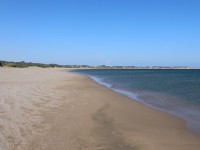
Agios Georgios (Agios Pavlos)
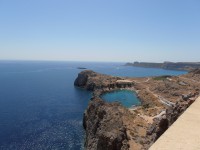
Agios Pavlos (Lindos - Saint Paul┬┤s Bay)
Limanaki beach
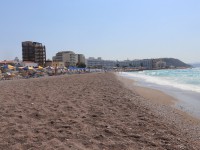
Akti Miaouli (Rhodes Town)
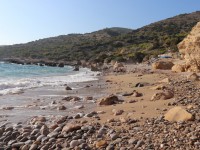
Alyki
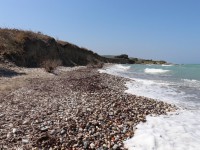
Anemomilos (Anemomylos)
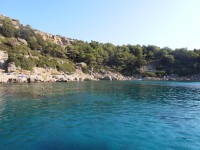
Anthony Quinn
Vagies
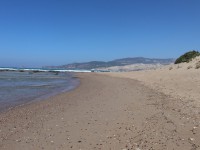
Apolakkia (Limni)
Limni Beach
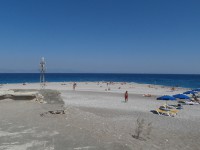
Elli (Rhodes Town)
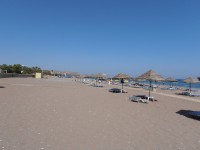
Faliraki
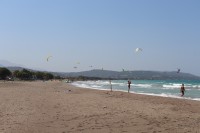
Fanes
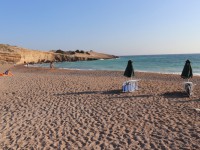
Fourni
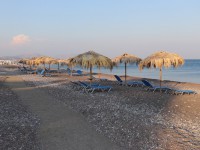
Gennadi
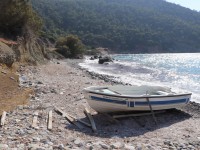
Glyfada (Glifada)
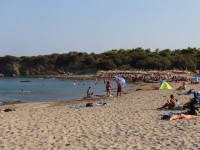
Glystra
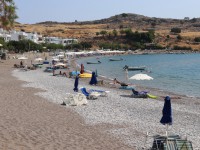
Haraki (Charaki)
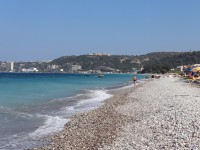
Ialyssos (Ialissos)
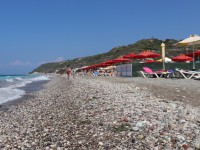
Ixia
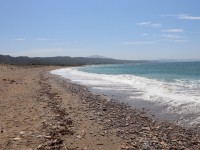
Kalamos
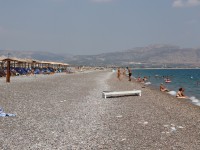
Kalathos
Kalavarda
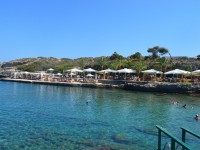
Kalithea
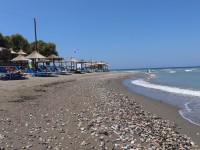
Kamiros
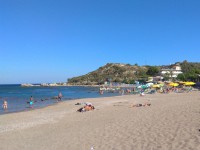
Kathara
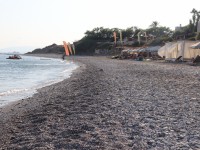
Katsouni
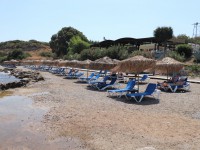
Kavourakia
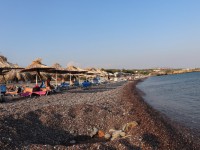
Kiotari
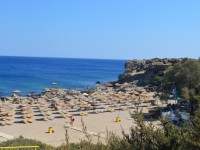
Kokkina
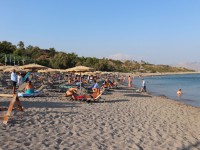
Kokkinogia
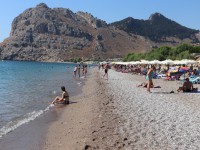
Kolymbia
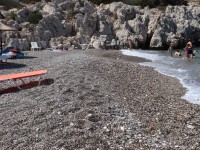
Kopria
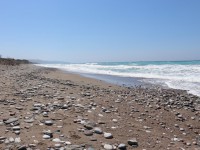
Kouloura
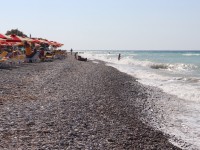
Kremasti
Kritika
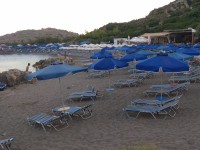
Ladikou
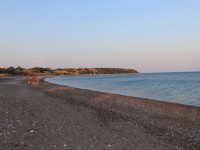
Lachania
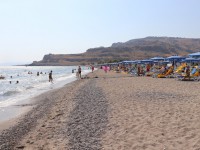
Lardos
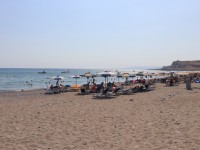
Lothiarika
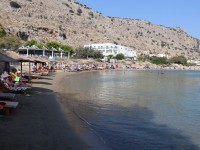
Makris Tichos
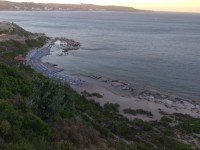
Mandomata
Mantomata Beach, Effi Beach
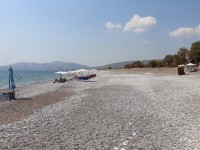
Massari
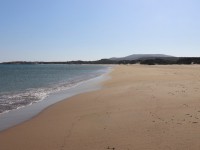
Mavros Kavos
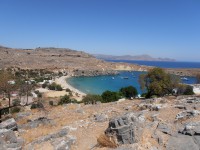
Megali Paralia (Lindos)
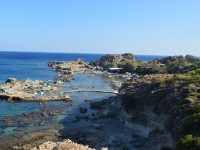
Nikolas
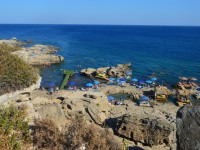
Oasis
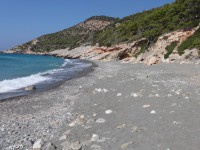
Paleochora
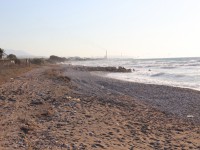
Paradisi (Paradeisi)
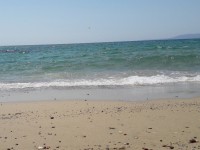
Pefki
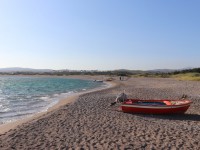
Plimiri
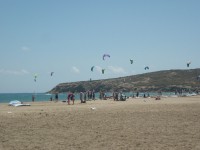
Prasonisi
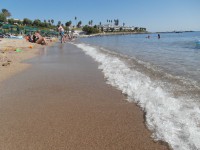
Reni Koskinou
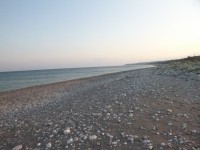
Salamina
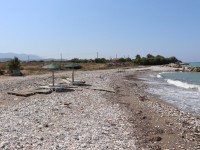
Soroni
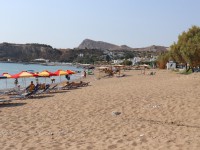
Stegna
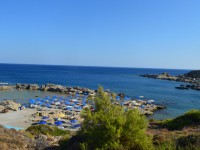
Tasos
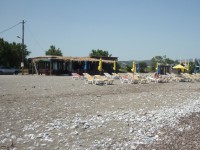
Theologos
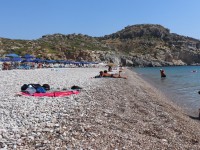
Traganou
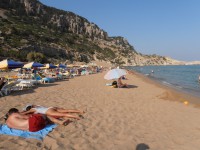
Tsambika
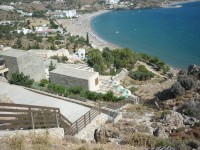
Vlicha
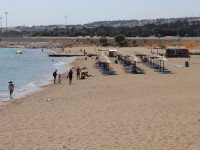
Zephyros
East vs. west coast of Rhodes
The coast of Rhodes is bathed by two different seas. While the eastern part of the island enjoys the calm Mediterranean Sea, the western coast experiences the wildness of the Aegean Sea. And the nature of the seas largely influences the nature of the beaches here.
The two seas meet at the northern and southern tip of Rhodes. In the north, this happens at the capital city of Rhodes, right in front of the famous marine aquarium with the sand and shingle beach of Elli. Sometimes a 'line' of a different shade of blue can be seen in the sea where the waters are mixing. In the south of the island, the seas meet at the beach and the islet of Prasonisi, a place known as the "kiss of the two seas". Prasonisi Beach has a form of two converging bays which together form a long strip of sand. This sandy strip connects Prasonisi with the mainland and is a popular destination for tourists, especially surfers.
In general, the beaches of Rhodes can be divided according to whether they are located on the eastern or western side of the island. The east coast of Rhodes is less rocky, the beaches are mostly sandy or sandy-shingly and the sea is calmer. The most popular tourist beaches on the whole island of Rhodes are located largely on its northeastern coast, where the most beautiful and longest beaches covered with fine sand can be found. The southeast coast of the island is much quieter.
The beaches on the eastern side of the island are especially popular among tourists for peace, swimming and relaxation and can be highly recommended for families with children or older people. Some of the most famous beaches in the east of Rhodes are for example Kalithea, Faliraki, Anthony Quinn, Ladikou, Afandou, Kolymbia, Tsambika, Vlicha, Pefki, Agios Pavlos, Prasonisi and others.
On the other hand, the west coast of the island is exposed to stronger winds and larger sea waves, which make it a suitable area for various water sports, primarily windsurfing and kitesurfing. The west coast is mostly covered with pebbles. The most popular beaches on the west coast of the island include Ixia, Theologos and others.
The beaches of Rhodes are also generally very well rated in terms of their cleanliness and tourist facilities. Many Rhodian beaches are regularly awarded with the so-called EU Blue Flag, traditionally Reni Koskinou, Kavourakia, Faliraki, Mantomata, Ladikou, Afandou, Kolymbia, Lardos, Gennadi, Kokkinogia, Kiotari, Trianta (Ialysos), Kalithea, Pefki, Vlicha and others.
East coast of Rhodes and its most popular beaches
The northeastern coast of Rhodes is almost entirely covered with beaches, both large and small, very busy and quieter. The northeast of Rhodes is the most attractive tourist area and the beaches here tend to be well-maintained and organised. For the most part, they have very good tourist facilities with sunbeds and umbrellas, tavernas and bars, as well as water sports.
Elli Beach (Rhodes Town) - One of the most beautiful beaches on Rhodes is located right on the northern tip of the island. Elli is a sandy beach, very lively and well equipped for tourists.
Kalithea Beach - a rocky cove where the famous thermal baths of Kalithea used to be located. Today, there is a small sand and shingle beach, equipped with umbrellas and sunbeds and with excellent conditions for lovers of relaxing diving and snorkelling.
Faliraki Beach - a beautiful sandy beach that is ideal especially for families with children. The beach is 5 km long and alternates between busy parts (especially those adjacent to the hotels) and quieter ones. The resort of Faliraki is generally visited for entertainment and attractions, and the same applies to its beach, which has excellent tourist facilities, including a range of water sports.
Anthony Quinn Bay (Vagies) - a pebble beach with a gradual entrance to the sea, quiet, equipped with sunbeds and umbrellas. Located in a small bay between the cliffs and is named after the famous American actor. Ideal conditions for diving and snorkelling.
Afandou Beach - a long (about 4 km) sandy-pebbly beach, partially organised and appreciated especially for its cleanliness and azure blue sea. A well-known Rhodian beach, very nice and less busy.
Kolymbia Beach - a long, sandy-pebbly beach, which is well organised and increasingly popular among tourists. A small rocky hill in the middle divides the beach in two parts, where the southern part is sandy to pebbly, with a gradual entrance to the sea and popular especially among families with children. The northern part of the beach is quieter and more rocky.
Tsambika Beach - traditionally rated as one of the most beautiful beaches on Rhodes. It is covered with perhaps the finest sand on the whole island, which not only small children like to bury themselves in. The beach is organised and quite busy in the main summer season. The eponymous Tsambika Monastery watches on a high hill over it.
Stegna Beach - a quiet, sandy to sandy-shingly beach, which is protected by the surrounding bay. The beach is organised and popular especially among families with children.
Agathi Beach (Agia Agatha) - a popular sandy beach with a gentle entrance to the sea and tourist facilities. Agathi is situated in a picturesque rocky cove and is traditionally considered as one of the most beautiful beaches on the island of Rhodes.
Lindos Beach (Megali Paralia) - a very picturesque beach, protected by the surrounding bay and with a stunning view of the old village of Lindos with its acropolis. The beach is covered with fine sand, which, together with the gradual entrance to the water, attracts families with children. In the main tourist season, it is usually completely full.
Agios Pavlos Bay (Limanaki) - a unique bay, which is otherwise completely enclosed by the surrounding rocks, except for a small canal. The local beach is sandy to sandy-pebbly and partially organised. The beach also belongs to the tourist resort of Lindos.
The southeastern coast of Rhodes is much more peaceful than the north, with smaller tourist resorts located further apart. However, the beaches here are also beautiful, mostly sandy or sandy-shingly, and there are often also unorganised, purely natural beaches, providing quiet and privacy.
Glystra Beach - a smaller, very pleasant beach covered with fine and golden sand. It is equipped with sunbeds and umbrellas and is one of the quiet beaches.
Gennadi Beach - a long and quiet pebble beach, equipped with sunbeds and umbrellas in the central part.
Plimiri Beach - a long, sandy and pebbly beach with crystal clear sea and a gentle entrance to the water. For the most part, the beach is left purely natural, only the part of the beach in front of the large hotel complex is organised (a clean sandy stretch of beach with sunbeds and umbrellas and water sports on offer).
Prasonisi Beach - a secluded beach at the very southern tip of Rhodes, with no beach service, but very interesting. The windswept beach with its wonderfully fine sand is described as a surfing paradise, as wind-surfers and kite-surfers head here in large numbers. In fact, Prasonisi beach is a strip of quicksand that connects the small island of Prasonisi to the mainland.
West coast of Rhodes and its most popular beaches
The northwest coast of Rhodes is specific in its surface and weather conditions. Unlike the eastern side of the island, the west is much windier and the sea is rougher, the coastline is rockier and the beaches are more often pebbly and stony. All of this provides ideal conditions, especially for water adrenaline sports.
Ixia Beach - a long and wide pebble beach, which provides its visitors good tourist facilities and a varied range of water sports (windsurfing, water ski, jet ski). The beach is part of the modern seaside resort of Ixia.
Ialysos Beach - a long pebble beach with good tourist facilities (sunbeds and umbrellas, many beach bars and taverns as well as various shops) and several surf schools. The beach is part of the modern and lively resort of Ialysos.
Beaches of Theologos, Fanes and Kalavarda - long, sandy (coarse sand) to sandy-pebbly beaches, especially famous among wind-surfers and kite-surfers. The beaches are quiet and partly organised.
The southwest coast of Rhodes is very deserted and wild, often with difficult access. There are considerably fewer beaches, of which most are purely natural.
Glyfada Beach - a secluded rocky beach surrounded by wild nature.
Fourni Beach - a quiet sand and shingle beach, located in a small cove directly below the ruins of the Johanniter castle of Monolithos. The beach is equipped with sun loungers and umbrellas and in high season, there is a mobile canteen with refreshments.
Rhodes island and water sports
There is a wide range of water sports on the beaches of Rhodes. Those who are interested have possibility to try for example water skiing, parasailing or jet skiing and they also can rent a pedal boat, kayak or even a motor boat. The west coast of Rhodes is then especially popular among wind-surfers and kite-surfers. But also beginners can try this sport, as there are several surf schools with instructors.
However, a separate chapter is diving, which is forbidden in the waters around Rhodes. Only a few dive centres have been granted an exception, and they are allowed to dive in designated areas. Both experienced athletes and participants in diving courses are allowed to dive at these places.
The bays of Rhodes are also a unique place for snorkelling.
Rhodes island and average sea temperature
Rhodes is often described as the sunniest Greek island and with 260 days of sunshine a year, it is one of the hottest islands in the Mediterranean. During the main summer season (that means from June to middle of September), the average maximum air temperature is between 28 and 31┬║C, while the average sea temperature during this period is between 23 and 25┬║C.
The temperature of the sea water belongs to the highest in the Aegean, making the waters of Rhodes an ideal place for diving and snorkelling. In general, the eastern side of the island is slightly warmer than the western side, mainly due to the influence of the sea currents and the wind. The sea warms up the most in the shallow bays on the east coast.
Map of Rhodes - beaches
The individual beaches of Rhodes, including the lesser-known and even hidden ones, are clearly marked on the Rhodes island map.
